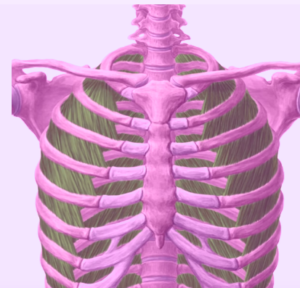Strained intercostal muscles are marked by extreme and sharp pain and spasms. Intercostal muscle strain and spasm is however self-restrictive and tends to normalize in a few weeks. Doctors may opt for varied treatment options like medicines, self-care, rest, etc.
Intercostal muscles: Description and function
Humans have 11 sets of intercostal muscles. They are present on the right and left sides of the chest in 3 different layers. The inner layer is called internal oblique intercostal muscle, the middle layer is known as transverse intercostal muscle, and the outermost layer is called external oblique intercostal muscle.
The three intercostal muscle layers connect to the intercostal space, i.e., the upper and lower area of the ribs. Its external and inner fibers have opposite and oblique routes, while the middle layer fibers have a horizontal passage in the area.
Intercostal muscles mainly assist in stabilizing the structure and maintaining the integrity of the chest wall. They also help join the different ribs together and play a vital role in respiratory processes.
Symptoms of intercostal muscle strain and spasm
A few common signs and symptoms of intercostal muscle strain and spam are listed below:
- Pain
- Patients may experience intense and continuous pain in the chest region. It is the most prevalent and noticeable symptom.
- Pain is unexpected, severe, and acute
- Tenderness may occur along with pain
- Pain is restricted to site with intercostal muscle strain
- Pain is sharp and radiating
- Examination of the affected site by touching or mild palpation can cause extreme pain
- Inflammation and swelling
- Intercostal muscle strain will cause inflammation of the muscles and the site
- Swelling usually occurs as a secondary effect of subcutaneous hematoma or muscle inflammation
- Tenderness may occur along with swelling and inflammation
- Respiratory problems
- Patients may have a shallow breath. Taking deep breaths may be problematic or difficult
- Breathlessness may occur as secondary effect of increased intensity of pain when inhaling
- Increased pain intensity may impede normal inhalation/exhalation
- Dyspnea or breathlessness may occur even with shallow breathing
- Other symptoms
- Patients may experience pain or difficulties when trying to move the upper body and/or the chest muscles so as to turn and look to one side.
- The chest wall may be stiff. Such stiffness is local and restricted to the site with intercostal muscle strain and spasm.
- Non-treatment of intercostal muscle spasm and strain may trigger pain even with mild motions of the chest, or with minor activities like sneezing, coughing, or even respiration.
Causes of intercostal muscle strain and spasm
Intercostal muscle strain and spasm may occur due to varied factors. A few common causes are mentioned below:
- Sudden and unexpected twisting of the upper area of the body
- Forceful activities that exert intense pressure or force on the chest region
- The intercostal muscles can strain or tear when the upper area of body is suddenly stretched or rotated. Sudden rotational motions or over stretching can occur when playing sports like American football, volleyball, basketball, badminton, or tennis.
- Injury or increased stretching of the intercostal space can occur with strong twisting of the chest or upper body area. This can cause the intercostal muscles to get pulled abnormally, thereby causing it to strain and spasm
- When an arm is forcefully swung to one side, then the rib cage also gets pulled to that side. When such forceful swinging motion of arm occurs along with opposite twisting of the lower part of the body, then it increases the risk of intercostal muscle strain or tearing. There is also the risk of intercostal muscle getting trapped inside the strained, spasmodic muscle, which can then trigger intense neuralgic pain at the site. Such contrary motions of upper and lower areas of the body marked by intercostal muscle rupture or strain usually occurs in people who play tennis, golf, and baseball, etc.
- Exercising or engaging in sports or games without first doing warm ups can increase the risk to intercostal muscle strain and spasm with even simple body twists or motions.
- The capacity of body for physical activities is limited. Hence, overexerting it can lead to weakness, tiredness, fatigue, inattention, and/or confusion. Performing chores or tasks when the body is overexerted can result in muscle strain and spasm.
- Direct forceful impact or trauma to the chest area can lead to intercostal muscle spasm and strain. Such injuries may occur in sportspersons or motor vehicle accidents.
Treatment of intercostal muscle strain and spasm
Healing and recovery of mild cases of intercostal muscle strain takes about 2 to 3 weeks, 6 to 7 weeks for moderate instances, and over 6 weeks for severe muscle strain and rupture:
Treatment involves:
- Bed rest, cold compresses, or ice packs
- Medications like muscle relaxants, painkillers, and NSAIDs
- Corticosteroid injections for alleviation of intercostal nerve block related pain and inflammation
- Certain stretching exercises as suggested by therapist.


